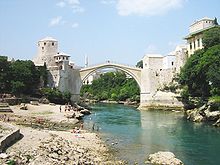Mimar Hayruddin | |
|---|---|
| Born | c. 1500 |
| Nationality | Ottoman |
| Occupation | Architect |
| Parent(s) | Ustad Murad, father, also an architect |
| Buildings | Stari Most Complex of Sultan Bayezid II Bayezid II Mosque |

Mimar Hayruddin (Hayruddin the architect; born c. 1500) was an Ottoman chief architect (Turkish: mimar) and civil engineer under the rule of Sultan Bayezid II (reigned 1481-1512/AH 886-918) and Sultan Suleiman the Magnificent (reigned 1520-1566).
A student of the celebrated Ottoman architect Mimar Sinan, Hayruddin was responsible for the construction of the Stari Most (Mostar Bridge) in the city of Mostar in Bosnia and Herzegovina,[1] the Bayezid II Mosque in Istanbul, the Külliye Complex of Sultan Bayezid II in Edirne, and another in town of Amasya.[2][3]
The Stari Most, in particular, is considered an exemplary piece of Balkan Islamic architecture.[4] Legend has it that Hayruddin was convinced his design would fail and, after nine years of construction, prepared himself to die on the day the bridge was finally unveiled.[5] Hayruddin's design was to endure until the destruction of the bridge by Croat forces in 1993.[6] The bridge was reconstructed, with work taking place from June 2001 until the new bridge was unveiled on 23 July 2004, at a cost estimated to be some 15.5 million US dollars.[7][8]
The Sultan Bayezid II complex is located on the banks of the Tunca River, consisting of a mosque, medical school, hospital and bathhouse, and in 2019 attracted some 7,000 tourists daily.[9]
Mimar Hayrüddin is considered to be one of the founders of the classical Ottoman style in architecture.[3]
- ^ "Stari Most by Mimar Hajruddin at GreatBuildings". GreatBuildings. Retrieved 2019-07-30.
- ^ "Edirne - Sultan II. Bayezid Külliyesi Sağlık Müzesi, Kültür Varlıkları Müzeler Genel Müdürlüğü web sitesi, Erişim tarihi:07.04.2011". Archived from the original on 2017-02-11. Retrieved 2019-07-30.
- ^ a b "Mimar Hayrüddin, Ottoman Architect". archnet.org. Retrieved 2 March 2020.
- ^ Stratton, Arthur (1972). Sinan. New York: Charles Scribner's Sons. ISBN 9780684125824.
- ^ O’Connor, William (2016-10-02). "Is the Rebuilt Stari Most the World's Most Beautiful Bridge?". Retrieved 2019-07-30.
- ^ Liu, Shuang, 1959- (2011). Introducing intercultural communication : global cultures and contexts. Gallois, Cynthia., Volčič, Zala. (1st ed.). London: SAGE. p. 201. ISBN 9781848600355. OCLC 688576638.
{{cite book}}: CS1 maint: multiple names: authors list (link) CS1 maint: numeric names: authors list (link) - ^ Armaly, Maha; Blasi, Carlo; Hannah, Lawrence (2004). "Stari Most: rebuilding more than a historic bridge in Mostar". Museum International. 56 (4): 6–17. doi:10.1111/j.1468-0033.2004.00044.x. S2CID 161607816.
- ^ Tecco, Simon (2004-07-24). "El Viejo Puente de Móstar vuelve a unir orillas y sentimientos". ABC (in Spanish). Retrieved 2020-11-22.
- ^ "Sultan Bayezid II Complex in northwest Turkey attracts thousands". Hürriyet Daily News. Retrieved 2019-07-30.